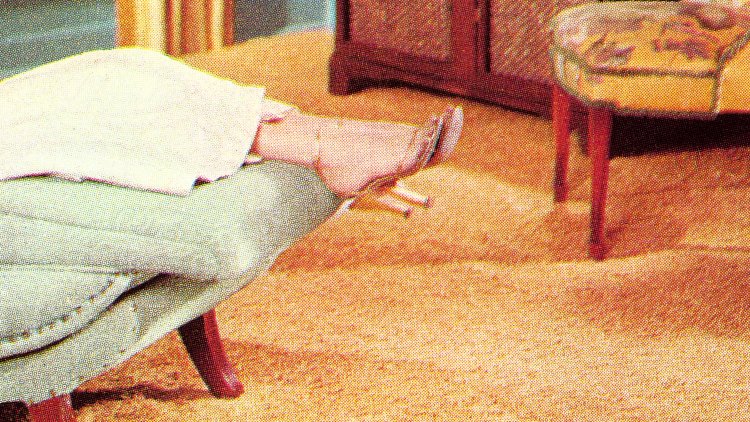Stop Looking at Your Therapist
The couch is there for a reason.

A person who is “on the couch” is known to be in therapy, but most therapists these days don’t ask their clients to lie down. The first time mine did, I resisted. I didn’t want to be on display or unable to see her reactions. Plus, the idea seemed antiquated. Sigmund Freud was inspired to use the couch more than a century after observing dramatic hypnotherapy demonstrations by his teacher Jean-Martin Charcot. In psychoanalysis, Freud thought a therapist being out of view would help people access emotions or memories that might be repressed. (He also said that he could not “put up with being stared at by other people for eight hours a day.”)
Many of Freud’s ideas about the unconscious haven’t held up, but he may have been onto something with the couch, as I discovered when I eventually followed my therapist’s suggestion. The couch might not be for everyone, but it could be worth a try.
Today, therapists’ offices still almost always have a couch. For his book, In the Shadow of Freud’s Couch, Mark Gerald, a psychologist trained in psychoanalysis, took portraits of therapists in their offices, and “it was a rare room that did not have a couch,” he told me. “Somebody once mentioned they actually never used the couch with their patients, but if they didn’t have a couch, they wouldn’t feel like a psychoanalyst.”
Despite the ubiquity of the therapist’s couch, research on instances when it is and isn’t helpful is limited. Some patients in case studies report that they’ve missed seeing their therapists’ face when they lie down, while others have used the couch to avoid direct face-to-face communication. Even Freud wasn’t always strict about the couch. He also took walks with his patients; he famously analyzed the composer Gustav Mahler during a four-hour walk around Leiden.
But for me—and, I suspect, many others—occasionally lying down might provide some relief from the social aspects of talking with a therapist.The relationship between a therapist and a client won’t fully disappear, and that dynamic can be useful to examine in therapy too. Yet many therapy clients place too much emphasis on interpersonal dynamics. On social media, people make jokes about how much they want to get an A+ in therapy or make a therapist laugh; I’ve felt the same pressures myself. That stress could be reduced when you’re lying down and physically incapable of scanning your therapist’s face for signs of approval or displeasure. And in a time when many people have switched to teletherapy, staring at your therapist’s face (or your own) over Zoom can feel like a work meeting gone wrong.
On a very simplistic level, the couch offers a change in perspective—literally. The ancient Greeks and Romans reclined during banquets, which created an atmosphere of comfort and intimacy, says Nathan Kravis, a psychiatrist and historian of psychiatry at Weill Cornell Medical College who’s also the author of On the Couch. In the modern world, lying down signifies that the conversation you’re about to have in therapy is a different kind of interaction than those you have with family or friends. It’s a time to confront difficult thoughts, admit shortcomings, or explore desires without the relational obligations to those we know in our “real” life. “Its strangeness is part of the power,” Kravis told me. “It really has no parallel anywhere else in our social world.”
Lying down may also better satisfy people’s hunger for a more creative and humanistic form of therapy. Over the past few years, interest in psychoanalysis has made a dramatic comeback, though the approach still makes up a minority of therapy sessions. Other therapeutic methods, such as cognitive behavioral therapy, aim to change thoughts and behaviors that aren’t working for you; psychoanalysis, by contrast, focuses on self-exploration. I did CBT for years, and it’s very effective at solving problems. Yet something about a therapeutic practice that’s not as goal-oriented can be healing. When I started to lie down, I felt that I was choosing to make space for reflection, grief, processing, and developing intimacy with my own mind in a world where such acts are not usually prioritized.
Lying down for therapy sessions could make a practice that’s costly in both time and money feel even more indulgent, and I’m sure that some people simply wouldn’t like it. But it’s available to everyone to try at least once. Lying down is a technique, not an end goal, Ahron Friedberg, a licensed psychoanalyst and board-certified psychiatrist, told me. It could be a way of cultivating comfort, intimacy, and reflection, or speaking in a manner that you’re not used to—to yourself or to a therapist.
[Read: Plenty of people could quit therapy right now]
In Gerald’s office, he provides choices. There’s a chair directly across from where he sits. There’s a couch, recently replaced because the original became saggy from years of use. Some of Gerald’s patients always lie down; others save it for when they’re feeling overwhelmed. One patient usually sits up but will curl up into a ball on the couch when she’s going through a difficult time. Kravis said he talks with a new client face-to-face, then gives them the option of lying down after a session or two. “It’s not mandatory,” he said. “You’re not Velcroed to the couch.”
What's Your Reaction?




















